Wildflowers, Grasses and Other Nonwoody Plants
Media

Species Types
Scientific Name
Trifolium pratense
Description
Red clover, or purple clover, is the familiar large, pinkish-purple clover that grows in lawns, pastures, and roadsides statewide. A Eurasian native, it was introduced to North America by the middle 1600s.
Media
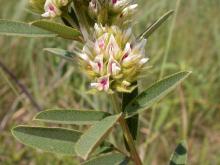
Species Types
Scientific Name
Lespedeza capitata
Description
Round-headed bush clover is a stiffly upright plant that has rounded flower clusters with cream-colored, pea-shaped flowers with purple markings on the banner petal. It grows statewide in open habitats.
Media
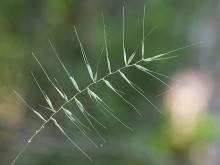
Species Types
Scientific Name
Elymus hystrix
Description
Bottlebrush grass is a native perennial, tuft-forming wild rye that typically grows in woodlands. The widely spaced spikelets spread away at a right angle from the main flowering stem.
Species Types
Scientific Name
Bromus pubescens (formerly B. purgans)
Description
Several species of brome grasses are found in Missouri. Canada brome, or hairy woodland brome, is one of the few that are native. It grows to 4 feet high, and its open flower clusters have drooping spikelets.
Media
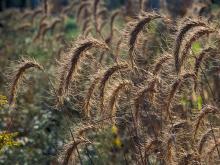
Species Types
Scientific Name
Elymus canadensis
Description
Canada wild rye can be identified by its bristly seed heads, which curve downward. As the seeds mature, the straight, long awns curve and bend. This is a common native cool-season grass that reaches about 4 feet tall and is highly valued as forage and hay for livestock.
Media
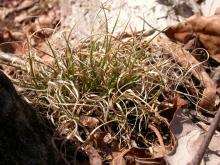
Species Types
Scientific Name
Danthonia spicata
Description
A common sight in dry upland Ozark woods, poverty grass is a species you can identify by its leaves alone. The basal leaves persist for several years, becoming dry and curly. Although the flowering stems can be 2 feet high, the basal leaves are only about 5 inches long.
Media
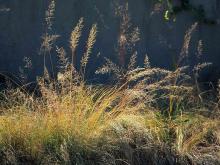
Species Types
Scientific Name
Sporobolus heterolepis
Description
Prairie dropseed is a native perennial bunch grass that forms dense clumps of fine, light green, arching leaves. The seed heads are airy, open, branching clusters bearing small, ovate florets on their own individual branchlets.
Media

Species Types
Scientific Name
Buchnera americana
Description
American bluehearts is a single or few-stalked wildflower of prairies and glades. It has distinctive, showy purple flowers that turn black as they age.
Media

Species Types
Scientific Name
Phlox pilosa
Description
Downy phlox, also called prairie phlox, is a perennial wildflower with lance-shaped leaves and showy, rounded clusters of pink or lavender flowers. It is similar to blue phlox, but it grows more often in prairies and other open, sunny, and drier habitats.
See Also
About Wildflowers, Grasses and Other Nonwoody Plants in Missouri
A very simple way of thinking about the green world is to divide the vascular plants into two groups: woody and nonwoody (or herbaceous). But this is an artificial division; many plant families include some species that are woody and some that are not. The diversity of nonwoody vascular plants is staggering! Think of all the ferns, grasses, sedges, lilies, peas, sunflowers, nightshades, milkweeds, mustards, mints, and mallows — weeds and wildflowers — and many more!





















